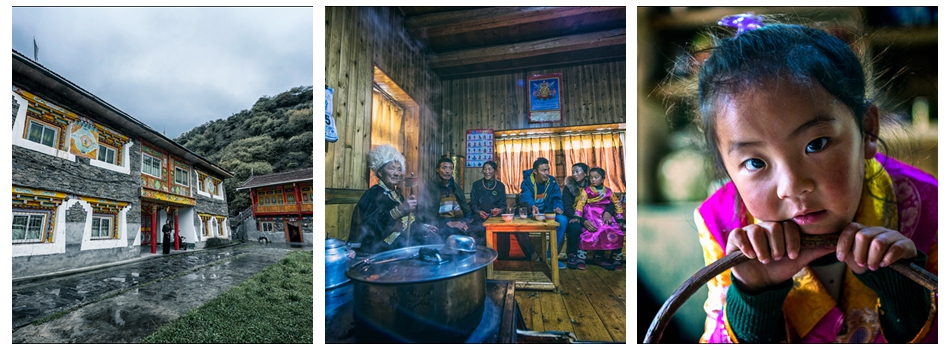Life of an ordinary family in Dagu
 0 Comment(s)
0 Comment(s) Print
Print E-mail China.org.cn, November 21, 2017
E-mail China.org.cn, November 21, 2017
[Photo by Liu Jie/China.org.cn]
People are drawn to Dagu not only by its natural beauty but by its simple and nice people.
Located in Heishui County, Aba Tibetan and Qiang Autonomous Prefecture, Sichuan, Dagu is home to the world’s youngest glacier which stands lofty and mystical. Mountains there are covered with diversely-tinted plants. Lakes formed as a result of the glacier melting are like jades decorating the mountains.
The place is a dream getaway for urbanites. Whiling exploring the place, they find the lives of local Tibetans are of great interest to them.
Dagu mean “beautiful deep valley” in Tibetan. Down in this valley there are three villages shrouded in mystery, namely Upper Dagu Village, Middle Dagu Village and Lower Dagu Village. The three villages have a long history, dating from 556 BC.
En Dengduo and his ordinary family live in Middle Dagu Village. The village becoming part of the Dagu Glacier Scenic Area has generated many jobs for local people. En Dengduo found a job as a forest ranger with the Luogesi Station of the scenic area.
Middle Dagu Village is surrounded by mountains and looks even more like a fairyland with mist enveloping it after rain.
In the village, you can also see towering ancient trees, babbling brooks and prayer wheels which are erected along the brooks and revolve with a squeaky sound under the force of the flowing brooks.
Roadside Tibetan houses are all decorated with traditional Tibetan patterns.
En Dengduo’s house is newly built. He and his family lived in their old house on the mountain before 2008. The local government later helped them to relocate to the foot of the mountain because of potential geological disasters.
En Dengduo and his family now live on collecting medical materials and raising yaks.
They collect especially wild caterpillar fungus.
“We dig the fungus during the month from the end of April to the end of May,” En Dengduo said. “We can gather more than ten to thirty each day. Fresh ones can sell at a high price and even dried ones can sell at 30 yuan each.”
Inside En Dengduo's house, there is a storeroom which is not big and filled with grains, preserved meat and butter cakes. These are primary food items for the family, especially butter. The butter is made from milk produced by the ten dairy cows raised by the family.
“The milk produced by the cows are all consumed by ourselves and is not for sale,”said En Dengduo’s wife.
The family also raises over 100 yaks. This, together with En Dengduo’s salary, enables the family to live a prosperous life.
Their new house is meant to accommodate tourists, but the family has to wait until the village comes up with a holistic plan that allow locals to accommodate tourists.
“When the “Happy Tibetan House” program is launched, we will have a new source of income,” said En Dengduo’s wife.
A program to restore arable land to forestry has eased local transportation and then local education.
En Dengduo’s two children have both entered school. The younger of the two, a four-year-old girl, is studying at a village kindergarten that teaches in both Chinese and Tibetan.
“The policies are now better, so do our lives,” En Dengduo’s mother said gaily. “When we were young, we had to climb over a mountain to attend school. No need to say that it was really cold in the winter, but the real danger is the bears roaming the mountains.”
The stove fire in the living room was burning briskly, warming up everyone in the room. En Dengduo’s grandma, wearing a white fur hat and a Tibetan dress, was chanting in a low voice. Beside her was a prayer wheel. Her great granddaughter then ran into her arms affectionately.






Go to Forum >>0 Comment(s)